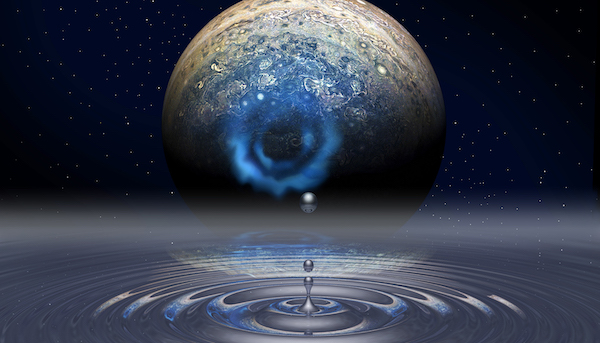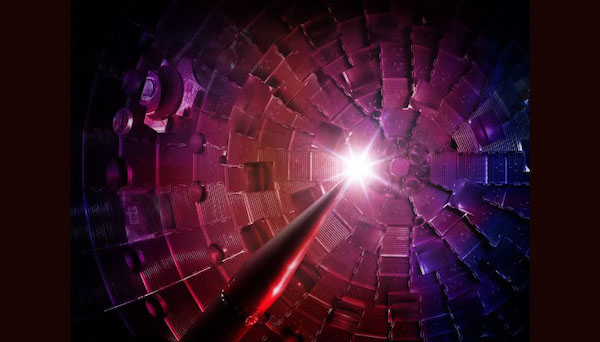Under Pressure: The Astonishing Behavior of Materials in Extreme Conditions
Experiments with plasma under ultrahigh pressures discover unexpected silicon phases, metallic deuterium, and 400-times-stronger lead.
November 9, 2020
VIRTUAL MEETING (CST) -- The pressure of the Earth’s inner core is 350 gigapascals (GPa), or 3.5 million times higher than the atmospheric pressure at sea level. Under such extreme conditions, planetary materials, like hydrogen and silicon, and common materials, like lead, can change their density, temperature, atomic lattice structures, and strength. With the advent of high-energy-density facilities, such as the National Ignition Facility (NIF), the Linac Coherent Light Source (LCLS), and the Z facility, these ultra-high pressures are reachable.
Properties of materials under extreme conditions are of great interest to a number of fields, including planetary physics, material science, and inertial confinement fusion. For example, in geophysics, studying the equations of state of different planetary materials under ultrahigh pressure and density provides a better understanding of the Earth’s formation and interior structure.
Combining the principles of plasma physics in extreme conditions with the development of advanced diagnostics technology has led to astonishing discoveries. Dr. Hye-Sook Park of Lawrence Livermore National Laboratory will discuss key findings at the virtual 62nd Annual Meeting of the APS Division of Plasma Physics.
Scientists in the field of high-energy-density physics investigate how the states of matter change under extreme pressures: approximately 100 GPa to 10,000 GPa, or 1 million to 100 million times the atmospheric pressure at Earth’s surface. Major discoveries to be discussed include:
- Extreme pressure shocks cause new phases in materials. While static compression is the application of balanced forces causing a steady increase of pressure on a material sample, shock compression is a process of applying huge forces over short periods of time, resulting in rapid pressure increases “shocking” the material. Using powerful lasers to drive the shock and extremely bright X-rays to image the material structure, scientists at the SLAC National Accelerator Laboratory have demonstrated that shock compression of materials (such as silicon and antimony) results in unexpected new phase states that do not occur under steady compression at similar pressures. For example, they demonstrated that shock-compressed silicon exhibits transition to a liquid state at different pressures than in the static compression case.
- A pressure of 200 GPa turns fluid deuterium into metal. Deuterium is a hydrogen isotope, which has a nucleus consisting of one proton and one neutron. At atmospheric pressure, deuterium atoms form molecules, and the material behaves as an insulator. A group of scientists at the NIF compressed deuterium samples using 168 laser beams, resulting in pressures of up to 600 GPa. Their groundbreaking study demonstrated that at 200 GPa, liquid deuterium transforms from molecular insulator to atomic metal. This discovery is crucial for understanding the planetary core structure of gas giants, such as Jupiter and Saturn, and many extrasolar planets, where pressures reach millions of atmospheres.
- Lead becomes stronger than steel at pressures of 350 GPa. Under atmospheric conditions, lead is a relatively soft and easy to scratch material. In another set of experiments at the NIF, researchers compressed a lead sample by blasting it with lasers to study how the material deforms under extreme conditions. Their experiments demonstrated that when the pressure reaches about 350 GPa—similar to the pressures found within Earth’s core—lead’s material strength increases by 400 times (Figure 2). Material deformation at high pressure and strain rate is a rapidly increasing area of research with applications in geophysics, inertial fusion, and ballistic penetration and advanced armor design.
This work was performed under the auspices of the U.S. Department of Energy by Lawrence Livermore National Laboratory under Contact No. DE-AC52-07NA27344.
Abstract:
PT02.1 Studying materials under extreme states of high-energy density compression
2:00 p.m. - 3:00 p.m. CST, Wednesday, November 11, 2020

Figure 1. Unraveling the properties of fluid metallic hydrogen at the NIF could help scientists unlock the mysteries of Jupiter’s formation and internal structure. Credit: Mark Meamber/LLNL.

Figure 2. Artist’s rendering of the interior of the NIF Target Chamber. In these experiments, 160 of the NIF’s 192 beams converge at the center of the chamber, driving the sample to pressures several million times the pressure of the atmosphere, similar to those found at the center of the Earth.
Media Contact
APS Press Office
media@aps.org
Hye-Sook Park
Lawrence Livermore National Laboratory
park1@llnl.gov
